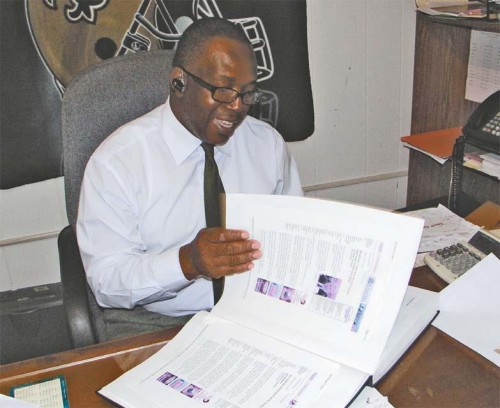
Tillman talks Terrebonne, reflects on vital three terms
September 6, 2011Thursday, Sept. 8
September 8, 2011With prep football among us, keeping that sometimes 100-degree heat in check is just another challenge local coaches and players say they deal with daily as they try and get ready for the new season.
“This is my 15th year in South Louisiana having to do football practices and I don’t remember ever going through something this hot,” Terrebonne football coach Gary Hill said. “I don’t ever remember it being this dry with this humidity. It’s like every day you turn on the TV and you see, ‘Heat Warning,’ ‘Heat Warning.’ I don’t ever remember that occurring.”
School lets out at approximately 2:30 p.m. for most local high schools.
Football practice begins shortly thereafter at approximately 2:45 or 3 p.m. depending on the program.
Scientific studies show the peak hours for heat are from noon to 4 p.m.
“We practice right in the middle of the worst of it,” E.D. White football coach Kyle Lasseigne said.
To keep up with the painful temperatures, local coaches have adopted a few universal strategies.
The first is to take breaks, lots and lots of breaks.
With players lugging heavy gear around practice, sweating can occur, sometimes even by the gallon for some players.
To keep up with fluid intake and avoid dehydration, coaches are budgeting for more stoppage time in their practice schedules.
“We break the kids every 20 minutes for water,” Thibodaux coach Chris Dugas said. “We try and make sure during those breaks they stay in the shade for at least a good 5-to-10 minutes before we get back on the field.”
Terrebonne follows a similar plan, but takes it a step further. Instead of doing running drills following practice, the Tigers condition during football P.E. class.
That allows players to replenish their bodies before practice.
“That’s done so our kids can have time to regenerate and rehydrate themselves before practice,” Terrebonne coach Gary Hill added. “Once in practice, everything we do, we’re doing it at a fast pace with a fast tempo, giving them a lot of breaks in between.”
The second common trend among local coaches is heat education.
Coaches say they’ve talked to their teams about the heat.
Others tout they have even put heat safety on the agendas of team meetings.
“We definitely make sure our guys know that it’s there,” Lasseigne said. “We tell them to make sure to keep hydrated throughout the day so when practices comes, they can be ready. … As much ice, water and Florida Water as we can get out here, that’s how we handle it.”
Dugas outlined his plan to keep his players safe.
He said the key to success is 24-hour hydration.
“It all starts the night before,” Dugas said. “We tell our guys to stay away from the sugary drinks. Stay away from the energy drinks, because those are the worst. Drink lots and lots of water at home. We tell the kids that if they don’t want to buy bottled Powerade, we’ll get them some powder mix or something. If you wait to start the next day, it’s too late.
“Make sure you eat lunch. Make sure you eat breakfast,” Dugas added. “Don’t skip a meal, because you need to have the correct amount of nutrients in your body, so when you lose some, you still are in balance.”
If all else fails, Tri-parish coaches say they have a zero-tolerance policy.
What that means is if a player appears to be fighting the heat, they pull him off the field and get him help, no questions asked.
With recent events in Georgia and Texas where players have died on the field due to heat exhaustion, coaches say they don’t want to have a similar event on their conscience.
“We’ve had one or two kids probably every practice who’ve struggled with the heat,” Lasseigne said. “We don’t take any chances with that. We’ll make them take their stuff off, get in the shade and cool down. This game isn’t that important in the big picture. It’s not worth taking a chance.”
Where some coaches are fighting through the sun, others are being even more cautious and are avoiding it altogether.
At Ellender, first-year coach Terry Washington pushed many of the team’s early fall practices to 5 p.m.
On the hottest days, the coach took it a step further and just kept his team indoors.
“I had heard that it was 100 degrees with a heat index of 115, so I just decided to keep the guys in the gym,” Washington said. “We didn’t go outside at all.”
With the season started, the Patriots are now on the field every day. But Washington said for the sake of both he and his players’ health, he will never ask them to battle the worst the sun has to offer.
“It’s been unbearable, really and truly, when you’re talking about 100, 110 or 115-degree temperatures,” Washington said. “That’s not good on neither me, nor the kids. I’m an older coach. … The other day, I was out there in the sun and I was seeing stars. So I know if I can feel it, the boys can too, so we’ll always protect them the best we can.”
With temperatures expected to gradually cool as the summer blends into the fall, the heat will no longer be as big an issue.
Until then, our local football teams will battle Mother Nature from Monday-Thursday, before battling their opponents under Friday night lights.
“I just don’t ever remember it being this hot,” Lasseigne said. “It just seems like it’s hotter than ever. To ask these kids to ignore that and pretend like it’s not part of what they’re dealing with, it just wouldn’t be right. … We factor for the temperatures in everything we do.”
Thibodaux defensive back Dwayne Reed soaks his head with water during a recent practice. With temperatures sometimes pushing 100 degrees locally, prep football players are trying to beat the heat this season. CASEY GISCLAIR













